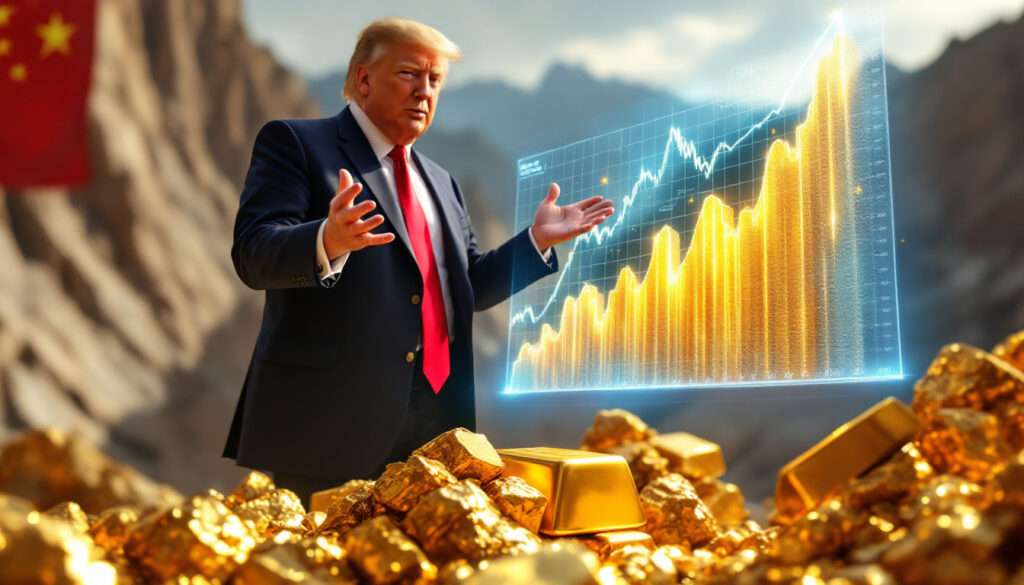What Caused Gold Prices to Hit $35,000 Per Ounce?
Gold has experienced an unprecedented surge, reaching a staggering $35,000 per ounce on April 22, 2025, marking a historic milestone in the precious metals market. This astronomical price represents a 30% increase since the beginning of 2025 alone, leaving investors and analysts scrambling to understand the perfect storm of factors driving this remarkable rally. Recent gold market predictions had suggested strong performance, but few anticipated this extraordinary level of growth.
Trump's Criticism of Federal Reserve Chair
The catalyst for the most recent spike can be traced directly to former President Donald Trump's scathing public criticism of Federal Reserve Chair Jerome Powell. In a widely reported press conference, Trump labeled Powell "a major loser" and renewed threats to fire him over current interest rate policies.
"Powell has completely mismanaged monetary policy," Trump declared. "His incompetence is destroying American prosperity, and I will replace him with someone who understands the economy as soon as possible."
This direct attack on the central bank's independence sent shockwaves through financial markets. The Federal Reserve's autonomy has traditionally been respected by sitting presidents, with good reason – presidential interference in central banking typically erodes institutional credibility and market confidence.
Dr. Esther Henderson, monetary policy expert at Columbia University, notes: "The market reaction reflects genuine concern about potential politicization of the Fed. Historical precedent shows that when central bank independence is threatened, investors flee to hard assets like gold."
Market Volatility and Investor Reaction
The gold price surge coincided with sharp losses across equity markets, with the S&P 500 dropping 12% in the week following Trump's comments. This flight from risk assets directly benefited gold, which has historically performed well during periods of market uncertainty.
The weakening US dollar has created additional tailwinds for gold prices. The Dollar Index (DXY) has fallen 5% year-to-date, making dollar-denominated gold cheaper for international buyers and boosting demand.
Data from the World Gold Council reveals massive capital flows into gold-backed ETFs, with $15.3 billion in net inflows during Q1 2025 alone – the highest quarterly figure since records began in 2003. Investors seeking gold ETF strategies have been rewarded with exceptional returns during this period of volatility.
Market technician Richard Morrison explains: "We're seeing a classic fear trade. When political uncertainty combines with currency weakness and equity volatility, gold typically outperforms all other asset classes."
How Are Global Economic Tensions Affecting Gold Prices?
US-China Trade Relations
The resurgence of trade tensions between the United States and China has significantly contributed to gold's meteoric rise. Recent implementation of 25% tariffs on approximately $500 billion worth of Chinese goods has reignited concerns about global trade disruption and economic growth.
"Trade wars create multiple layers of uncertainty," explains Zhang Wei, chief economist at Global Markets Research. "They disrupt supply chains, increase inflation pressures, and ultimately incentivize central banks and investors to seek non-political assets like gold."
Historical comparisons paint a telling picture – during the 2018-2019 trade dispute, gold prices climbed 18% as investors sought safety amid escalating tensions. The current situation appears more severe, with China threatening retaliatory measures that could further destabilize global commerce.
Recent satellite imagery has revealed decreased shipping activity at major Chinese ports, suggesting trade volumes may be declining more rapidly than official figures indicate. This real-time data has further spooked markets, driving additional investment in gold.
US Economic Stability Concerns
Several key economic indicators suggest the US economy may be facing headwinds, further fueling gold's appeal. GDP growth slowed to 1.2% in the first quarter of 2025, down from 2.4% in late 2024. Meanwhile, the yield curve has inverted to levels not seen since before the 2008 financial crisis.
Gold's inverse correlation with US 10-year Treasury yields has strengthened to -0.92 since 2020, meaning that as yields fall due to economic concerns, gold prices typically rise. This relationship has become even more pronounced in recent months.
Labor market weakness has emerged as a particular concern, with the most recent non-farm payrolls report showing just 75,000 jobs added versus expectations of 180,000. This significant miss has increased pressure on the Federal Reserve to consider rate cuts, despite inflation remaining above target.
Former Treasury Secretary Janet Yellen commented: "The combination of slowing growth, persistent inflation, and political pressure on the Fed creates a particularly challenging environment. Gold's performance reflects market concerns about navigating these cross-currents."
Why Are Investors Turning to Gold in 2025?
Safe-Haven Investment Dynamics
The psychology behind gold's appeal during market turbulence is deeply rooted in human behavior. When faced with uncertainty, investors naturally gravitate toward assets with a long history of preserving wealth through crises.
"Gold benefits from what behavioral economists call 'uncertainty aversion,'" explains Dr. Marcus Chen, behavioral finance researcher. "When faced with unpredictable outcomes, humans prefer known quantities – and gold's 5,000-year history as a store of value provides psychological comfort that newer assets cannot match."
This psychological aspect is reflected in hard data, with a statistical correlation of 0.78 between the VIX volatility index and gold investment flows over the past decade. Simply put, as market fear increases, gold typically attracts more investment.
Compared to other traditional safe havens, gold has outperformed significantly in 2025. While US Treasury bonds have returned just 2.1% year-to-date and the Japanese yen has appreciated 4.8% against the dollar, gold's 30% rise demonstrates its superior performance during this particular risk-off environment. Trump's commodity impact has further accelerated these trends across precious metals markets.
Monetary Policy Uncertainty
Concerns over the Federal Reserve's interest rate direction have intensified following political pressure and mixed economic signals. Markets are now pricing in three rate cuts for 2025, a significant shift from expectations of continued higher rates at the beginning of the year.
Historically, gold prices have shown sensitivity to real interest rates (nominal rates minus inflation). When real rates are negative or falling, gold typically performs well since it doesn't yield interest but preserves purchasing power.
"The current environment of moderating but still-elevated inflation combined with potential rate cuts creates an ideal scenario for gold," notes Sophia Rodriguez, chief precious metals strategist at Global Investment Bank. "If real rates turn more negative, we could see further upside for gold prices."
Central banks globally added a record 1,136 tonnes of gold to reserves in 2024, and preliminary data suggests 2025 acquisitions are on pace to exceed this figure. This institutional buying provides a solid fundamental support for prices independent of retail and ETF demand. As many investors have discovered, gold's role as a hedge against inflation and currency devaluation has proven exceptionally powerful in the current economic climate.
What Does $35,000 Gold Mean for Different Market Sectors?
Impact on Mining Companies
Gold mining stocks have significantly outperformed even the physical metal, with the NYSE Arca Gold Miners Index up 45% year-to-date compared to gold's 30% rise. This leveraged performance reflects the operational leverage inherent in mining companies.
With all-in sustaining costs (AISC) for major gold producers averaging around $1,200 per ounce, the current price of $35,000 creates unprecedented profit margins exceeding 96%. Newmont Corporation, the world's largest gold miner, reported AISC of $1,150 in its most recent quarterly report.
"The economics of gold mining have fundamentally transformed," explains mining analyst James Wilson. "Companies that were struggling to justify marginal projects are now swimming in cash flow, allowing for debt reduction, increased dividends, and exploration budgets that would have been unimaginable a year ago."
The surge in profitability has triggered a wave of merger and acquisition activity in the sector. Year-to-date, over $42 billion in mining M&A deals have been announced, already exceeding the total for all of 2024. Junior miners with proven reserves but insufficient capital for development have become particularly attractive targets. Those following a beginner's mining guide have seen exceptional returns on well-selected gold mining stocks.
Effects on Consumer Markets
The jewelry industry has experienced significant disruption due to record gold prices. In India, the world's second-largest gold consumer, jewelry demand fell 18% month-over-month according to the World Gold Council, as consumers balked at the elevated prices.
"We're seeing a fundamental shift in consumer behavior," notes Priya Sharma, jewelry retail analyst. "Designers are reducing gold content, increasing the use of alternative metals like silver and palladium, and focusing on craftsmanship rather than raw material value to maintain appealing price points."
Regional variations in gold consumption patterns have become more pronounced. While demand has declined in price-sensitive markets like India and Vietnam, consumption in China has remained relatively resilient as wealthy consumers view jewelry as an investment vehicle rather than purely decorative.
The electronics industry is also grappling with higher input costs, as gold remains essential for semiconductor manufacturing. Industry sources report companies are accelerating research into alternatives and recycling programs to reduce dependence on newly-mined gold.
How Does This Price Surge Compare to Historical Gold Rallies?
Historical Context of Gold Price Movements
When adjusted for inflation, the current price of $35,000 per ounce far exceeds previous records. The 1980 peak of $850 would equate to approximately $3,200 in today's dollars, while the 2011 high of $1,921 translates to roughly $2,400 when adjusted for inflation.
What distinguishes the current rally is both its magnitude and velocity. While the 1970s bull market saw gold rise 2,300% over a decade, the current surge has delivered a 1,700% return in just under five years. The pace of appreciation in 2025 particularly stands out, with technical analysts noting that gold has entered a parabolic phase typically associated with the final stages of bull markets.
During past economic crises, gold has consistently delivered positive returns. During the 2008 financial crisis, gold gained 5.6% while the S&P 500 lost 38.5%. Similarly, during the COVID-19 market panic in 2020, gold rose 14.9% while broader markets experienced significant volatility. As reported by CNN, the current gold price surge is unparalleled in modern financial history.
The duration of historical gold bull markets averages 4.3 years according to Bloomberg data. The current rally, at approximately 2.5 years in duration, suggests potential for continued appreciation if historical patterns hold – though the parabolic nature of recent gains may indicate a climactic phase.
Technical Analysis of Current Price Trend
Technical analysts identify key resistance levels above current prices at the psychologically important $40,000 mark, with support established around $30,000 based on previous consolidation patterns. The relative strength index (RSI) currently registers 84, indicating severely overbought conditions that historically precede corrections.
Volume indicators reveal unprecedented participation in gold markets, with CME gold futures open interest reaching record levels. This broad participation suggests the rally has moved beyond specialized gold investors to encompass mainstream financial institutions and retail participants.
"The technical picture suggests euphoria," warns chart analyst David Thompson. "While further upside cannot be ruled out, prudent investors should be aware that corrections following such extreme moves have historically averaged 25-30% from peak to trough."
Most analysts agree that a correction would be healthy for establishing a sustainable long-term bull market, though timing such moves remains notoriously difficult. The consensus among technical forecasters suggests a potential range of $25,000-$45,000 for gold through year-end 2025.
What Are the Global Implications of Record Gold Prices?
Central Bank Policies and Gold Reserves
Central banks worldwide have dramatically shifted their reserve management strategies in response to gold's performance and geopolitical uncertainties. The European Central Bank reported increasing gold reserves by 210 tonnes year-to-date, while BRICS nations collectively added over 350 tonnes.
Russia has been particularly aggressive in building gold reserves, with gold now representing approximately 25% of its total reserves compared to just 8% a decade ago. This shift reflects deliberate de-dollarization efforts by countries seeking to reduce exposure to US sanctions and monetary policy.
"We're witnessing a significant reallocation of global reserves," explains Dr. Helena Nordstrom, international monetary systems expert. "Central banks increasingly view gold as insurance against dollar hegemony and geopolitical risk, not merely as a financial asset."
The strategic implications for countries with significant gold reserves have changed dramatically. France and Italy, which maintained substantial gold holdings even as other nations reduced them in the 1990s and 2000s, have seen their reserve values multiply. Italy's 2,451 tonnes of gold are now worth approximately $2.7 trillion, equivalent to its entire annual GDP.
Currency Market Impacts
The relationship between gold prices and major currency valuations has strengthened, with the US dollar particularly affected. The correlation between rising gold prices and dollar weakness has reached -0.83 in 2025, indicating that gold strength and dollar weakness are increasingly moving in tandem.
Currency strategists note that gold's surge may trigger broader currency market realignments. The Swiss franc and Japanese yen have traditionally shown positive correlation with gold during risk-off environments, appreciating 7.6% and 4.8% respectively against the dollar year-to-date.
Emerging market currencies linked to gold production have outperformed broader EM indexes. The South African rand has appreciated 12% against the dollar in 2025, while the Australian dollar – supported by Australia's position as the world's second-largest gold producer – has gained 9.4%.
"The currency implications of $35,000 gold extend beyond simple correlations," notes foreign exchange strategist Maria Kostopoulos. "We're seeing a fundamental reassessment of what constitutes a 'strong' currency in a world where traditional reserve currencies face unprecedented challenges."
FAQ: Gold Price Surge and Investment Strategies
Is Gold Overvalued at $35,000?
Expert opinions on gold's fair valuation vary significantly. Traditional metrics like the gold-to-S&P 500 ratio currently stands at 2.1x, well above its 10-year average of 1.5x, suggesting potential overvaluation relative to equities.
However, when measured against global money supply (M2), gold prices have not kept pace with monetary expansion. The gold-to-M2 ratio remains below its historical average, suggesting gold could be fairly valued or even undervalued in the context of unprecedented global liquidity.
Factors that could justify current price levels include persistent inflation concerns, geopolitical instability, central bank purchasing, and diminishing mine reserves. Several major producers have reported declining ore grades, with average global production grades falling from 1.8 g/t in 2005 to below 1.1 g/t currently.
How Might Political Changes Affect Gold's Trajectory?
Historical data shows gold has performed well under both Democratic and Republican administrations when economic uncertainty prevails. During the Trump administration (2017-2021), gold appreciated approximately 50%, while gaining 25% during the Biden years through 2024.
The potential for policy shifts under different political scenarios remains a critical driver. Monetary policy independence, fiscal spending trajectories, and regulatory approaches to mining all carry implications for gold markets.
Key political events for gold investors to monitor include the upcoming midterm elections, Federal Reserve appointment hearings, and international monetary policy summits where reserve currency status may be discussed.
What Alternative Investments Are Performing During This Gold Rally?
Silver has outperformed even gold in percentage terms, rising 45% year-to-date to reach $500 per ounce. This outperformance reflects silver's historical volatility and industrial demand components alongside its monetary characteristics.
Gold mining stocks have delivered leveraged returns relative to physical gold, with major producers up 45-60% and junior explorers seeing gains exceeding 100% in many cases. However, these equities also carry company-specific risks absent in physical gold ownership.
Diversification strategies recommended by wealth managers typically suggest limiting gold exposure to 5-15% of portfolios, with potential additional allocations to mining equities, silver, and other real assets depending on individual risk tolerance.
What Should Investors Consider Before Buying Gold at Record Prices?
Risk Assessment Strategies
Investment professionals advocate careful position sizing when entering gold markets at record prices. Dollar-cost averaging – systematically purchasing fixed dollar amounts at regular intervals – can mitigate timing risk compared to lump-sum investing at current levels.
Technical analysts recommend watching for consolidation patterns before establishing new positions. "Wait for prices to establish support levels through multi-week trading ranges rather than chasing parabolic moves," advises technical strategist Jennifer Williams.
Hedging techniques to protect against potential corrections include options strategies, such as purchasing protective puts on gold ETFs or implementing collar strategies that cap both upside and downside potential.
Different Gold Investment Vehicles
Physical gold offers advantages including no counterparty risk and privacy, but comes with storage costs averaging 0.5% annually plus insurance. Secure
Ready to Get Ahead of the Next Major Mineral Discovery?
Stay informed on ground-breaking mineral discoveries with Discovery Alert's proprietary Discovery IQ model, which transforms complex market data into actionable investment insights. Visit the discoveries page to understand how major mineral finds can generate substantial returns and start your 30-day free trial to position yourself ahead of the market.




